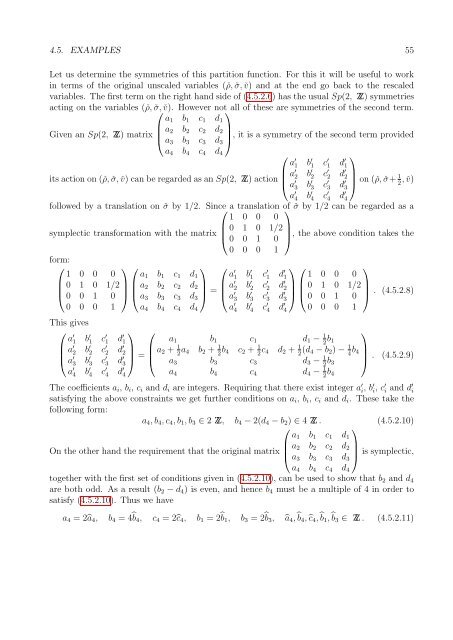PHYS08200604018 Shamik Banerjee - Homi Bhabha National ...
PHYS08200604018 Shamik Banerjee - Homi Bhabha National ...
PHYS08200604018 Shamik Banerjee - Homi Bhabha National ...
Create successful ePaper yourself
Turn your PDF publications into a flip-book with our unique Google optimized e-Paper software.
4.5. EXAMPLES 55<br />
Let us determine the symmetries of this partition function. For this it will be useful to work<br />
in terms of the original unscaled variables (ˇρ, ˇσ, ˇv) and at the end go back to the rescaled<br />
variables. The first term on the right hand side of (4.5.2.6) has the usual Sp(2, Z) symmetries<br />
acting on the variables (ˇρ, ˇσ, ⎛ˇv). However not⎞<br />
all of these are symmetries of the second term.<br />
a 1 b 1 c 1 d 1<br />
Given an Sp(2, Z) matrix ⎜ a 2 b 2 c 2 d 2<br />
⎟<br />
⎝ a 3 b 3 c 3 d 3<br />
⎠ , it is a symmetry of the second term provided<br />
a 4 b 4 c 4 d 4<br />
⎛<br />
⎞<br />
a ′ 1 b ′ 1 c ′ 1 d ′ 1<br />
its action on (ˇρ, ˇσ, ˇv) can be regarded as an Sp(2, Z) action ⎜ a ′ 2 b ′ 2 c ′ 2 d ′ 2 ⎟<br />
⎝ a ′ 3 b ′ 3 c ′ 3 d ′ ⎠ on (ˇρ, ˇσ+ 1, ˇv) 2<br />
3<br />
a ′ 4 b ′ 4 c ′ 4 d ′ 4<br />
followed by a translation on ˇσ by 1/2. Since ⎛ a translation of ⎞ ˇσ by 1/2 can be regarded as a<br />
1 0 0 0<br />
symplectic transformation with the matrix ⎜ 0 1 0 1/2<br />
⎟<br />
⎝ 0 0 1 0 ⎠ , the above condition takes the<br />
0 0 0 1<br />
form:<br />
⎛<br />
⎞ ⎛<br />
⎞ ⎛<br />
⎞ ⎛<br />
⎞<br />
1 0 0 0 a 1 b 1 c 1 d 1 a ′ 1 b ′ 1 c ′ 1 d ′ 1 1 0 0 0<br />
⎜ 0 1 0 1/2<br />
⎟ ⎜ a 2 b 2 c 2 d 2<br />
⎟<br />
⎝ 0 0 1 0 ⎠ ⎝ a 3 b 3 c 3 d 3<br />
⎠ = ⎜ a ′ 2 b ′ 2 c ′ 2 d ′ 2 ⎟ ⎜ 0 1 0 1/2<br />
⎟<br />
⎝ a ′ 3 b ′ 3 c ′ 3 d ′ ⎠ ⎝<br />
3 0 0 1 0 ⎠ . (4.5.2.8)<br />
0 0 0 1 a 4 b 4 c 4 d 4 a ′ 4 b ′ 4 c ′ 4 d ′ 4 0 0 0 1<br />
This gives<br />
⎛<br />
⎞ ⎛<br />
a ′ 1 b ′ 1 c ′ 1 d ′ 1 a 1 b 1 c 1 d 1 − 1 ⎜ a ′ 2 b ′ 2 c ′ 2 d ′ 2 ⎟<br />
⎝ a ′ 3 b ′ 3 c ′ 3 d ′ ⎠ = b 2 1<br />
⎜ a 2 + 1<br />
⎝<br />
a 2 4 b 2 + 1b 2 4 c 2 + 1c 2 4 d 2 + 1(d 2 4 − b 2 ) − 1b 4 4<br />
3 a 3 b 3 c 3 d 3 − 1b a ′ 4 b ′ 4 c ′ 4 d ′ 2 3<br />
4 a 4 b 4 c 4 d 4 − 1b 2 4<br />
⎞<br />
⎟<br />
⎠ . (4.5.2.9)<br />
The coefficients a i , b i , c i and d i are integers. Requiring that there exist integer a ′ i, b ′ i, c ′ i and d ′ i<br />
satisfying the above constraints we get further conditions on a i , b i , c i and d i . These take the<br />
following form:<br />
a 4 , b 4 , c 4 , b 1 , b 3 ∈ 2 Z, b 4 − 2(d 4 − b 2 ) ∈ 4 Z . (4.5.2.10)<br />
⎛<br />
a 1 b 1 c 1 d 1<br />
On the other hand the requirement that the original matrix ⎜ a 2 b 2 c 2 d 2<br />
⎟<br />
⎝ a 3 b 3 c 3 d 3<br />
⎠ is symplectic,<br />
a 4 b 4 c 4 d 4<br />
⎞<br />
together with the first set of conditions given in (4.5.2.10), can be used to show that b 2 and d 4<br />
are both odd. As a result (b 2 − d 4 ) is even, and hence b 4 must be a multiple of 4 in order to<br />
satisfy (4.5.2.10). Thus we have<br />
a 4 = 2â 4 , b 4 = 4̂b 4 , c 4 = 2ĉ 4 , b 1 = 2̂b 1 , b 3 = 2̂b 3 , â 4 ,̂b 4 , ĉ 4 ,̂b 1 ,̂b 3 ∈ Z . (4.5.2.11)

















